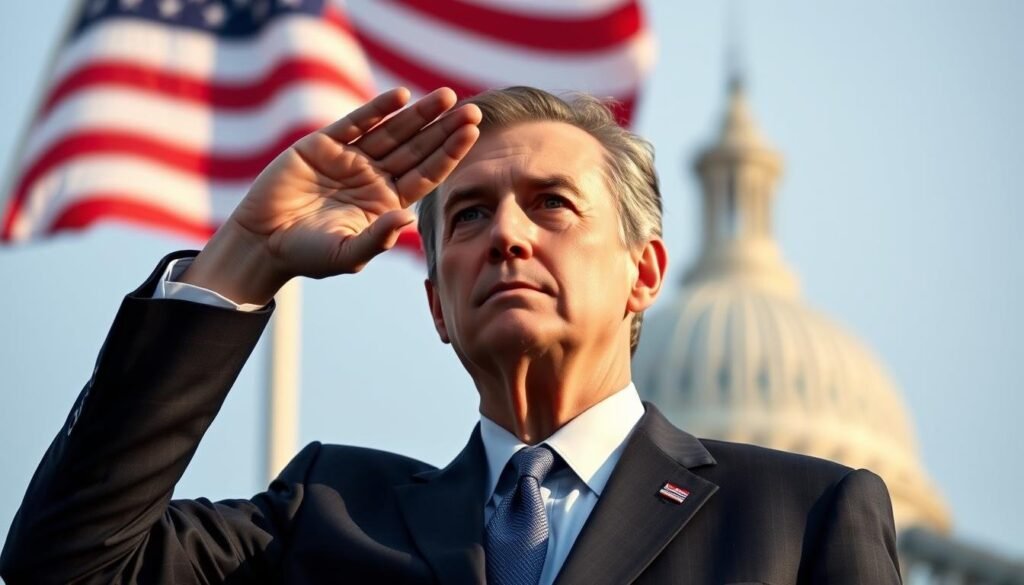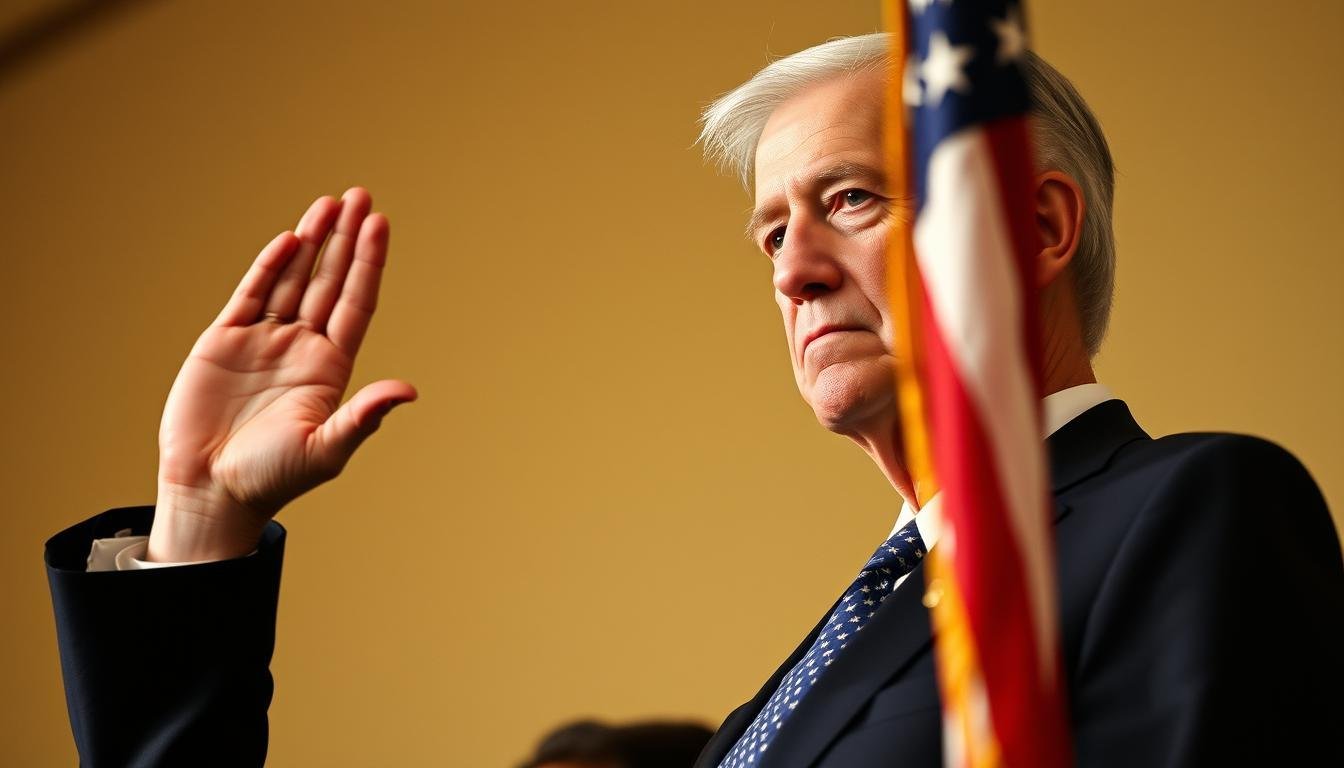Can a Former President Salute the Flag? Have you ever thought about the rules for saluting the national flag? Especially when it’s done by high-ranking people like former presidents? The presidential salute shows respect and love for the country. It comes from military traditions and national pride.
Looking into flag salute protocol shows it’s more than just saying hello. It’s a sign of loyalty and unity. For people like former presidents, there are strict rules to follow. These are part of former president etiquette.
Learning about these rules helps us understand the salute’s importance. It shows its value for national leaders.
Contents
- 1 The Presidential Salute Tradition
- 2 Military Protocol vs. Civilian Customs
- 3 Can a Former President Salute the Flag?
- 4 The Commander-in-Chief Role: During and After Office
- 5 Historical Examples of Former Presidents Saluting
- 6 The Symbolic Significance of Presidential Salutes
- 7 Public Perception and Controversy
- 8 Understanding the Presidential Salute Tradition
- 9 FAQ: Can a Former President Salute the Flag?
- 9.1 What is the protocol for a former President saluting the flag?
- 9.2 Are former Presidents still considered Commanders-in-Chief?
- 9.3 Can a former President receive military honors when saluting the flag?
- 9.4 What is the significance of a presidential salute?
- 9.5 Have there been any controversies surrounding former Presidents saluting the flag?
- 9.6 How do civilians differ from military personnel in saluting the flag?
- 9.7 What is the history behind the presidential salute tradition?
- 9.8 Can a former President’s actions, such as saluting the flag, be seen as representing the current administration?
The Presidential Salute Tradition
Ever wondered where the presidential salute comes from? It’s a tradition filled with history. This gesture shows deep respect and honor to the Commander-in-Chief.
Evolution of the Salute Protocol
The salute has changed over the years. It’s shaped by military customs and the president’s role as the armed forces’ leader. It was once a sign of respect and acknowledgment to a superior officer.
The salute’s evolution is linked to military honors and the president’s ceremonial duties. As the head of state, the president is honored with special rituals, like the salute.
| Aspect | Description | Significance |
|---|---|---|
| Military Honors | Rituals and ceremonies honoring the president | Reflects respect for the office and the person |
| Salute Protocol | Rules governing the performance of the salute | Ensures uniformity and discipline in military conduct |
| Presidential Salute Tradition | Historical and cultural context of the salute | Symbolizes the continuity and heritage of the office |
The presidential salute tradition mixes military etiquette with a symbol of respect for the highest office. Knowing its history and importance helps us understand the ceremonial side of the presidency.
Military Protocol vs. Civilian Customs
It’s important to know the difference between military protocol and civilian customs when saluting the flag. The military has strict rules for saluting, showing respect and discipline.
Military people must follow certain rules when saluting the flag. These include:
- Standing at attention
- Placing the right hand on the heart
- Removing headgear
Civilian Salute Customs
Civilians don’t have to follow the same rules as the military. But, they should still show respect during the salute. Civilians usually:
- Stand at attention
- Place their right hand over their heart
- Remove headgear as a sign of respect
The main difference is in the level of formality and actions needed. Military people have strict rules, while civilians show respect in a less formal way.
In short, knowing the difference between military and civilian salute customs is key. It helps show respect and follow etiquette rules.
Can a Former President Salute the Flag?
It might surprise you to learn that rules for a former president’s salute are complex. The tradition of saluting the flag is deeply rooted in American culture. Former presidents, having held the highest office, follow specific protocols.
When thinking about whether a former president can salute the flag, we must look at presidential protocol. As a former Commander-in-Chief, they have a special bond with the military. This bond affects their ability to salute.
Implications of Saluting for Former Presidents
Saluting the flag as a former president can mean different things. It can show respect, continuity, and patriotism. But, it also makes people wonder about the line between their former role and their current life as a private citizen.
| Aspect | Military Perspective | Civilian Perspective |
|---|---|---|
| Protocol | Follows military saluting traditions | Adheres to civilian customs and norms |
| Significance | Symbolizes respect and discipline | Represents patriotism and national pride |
| Implications for Former Presidents | Reflects their role as former Commander-in-Chief | Can be seen as a gesture of respect and continuity |
In conclusion, the choice for a former president to salute the flag is complex. It involves understanding presidential protocol and the implications of saluting. Both sides have valid points. It’s clear that such actions hold great importance in American society.
The Commander-in-Chief Role: During and After Office
Ever wondered how being the commander-in-chief changes a president? This role is both ceremonial and operational. It’s the highest rank in the armed forces.
While in office, the president oversees the military. They make big decisions on operations and represent the nation globally. This role is key for executing national security and handling global crises.
Changes in Role After Leaving Office
After leaving, a president’s role changes a lot. They can’t make military decisions or direct operations anymore. But, they still symbolically represent the military and attend ceremonies.
| Aspect | During Office | After Office |
|---|---|---|
| Decision Making | Directs military operations and makes key decisions | No longer has the authority to make military decisions |
| Ceremonial Role | Represents the nation in international and national military affairs | May participate in ceremonial events symbolically |
| Operational Influence | Oversees the military and executes national security policies | Limited to advisory or symbolic roles |

This change shows a shift from an active to a symbolic role. It affects how former presidents interact with military traditions, like saluting the flag.
Historical Examples of Former Presidents Saluting
Many former presidents have saluted the flag to show respect and patriotism. For example, at the Franklin D. Roosevelt Memorial in 1997, former President Jimmy Carter and others saluted. This was a sign of their respect and loyalty.
At President John F. Kennedy’s funeral, former President Dwight D. Eisenhower saluted the casket. This act showed deep respect and tradition. It’s clear that saluting is a meaningful gesture.
Significance of These Historical Examples
These examples show the lasting respect and patriotism of former presidents. By saluting, they show their commitment to the nation and its values. It’s a powerful way to show unity and respect.
- They highlight the importance of tradition and protocol in presidential gestures.
- They show how former presidents continue to be involved in national events and ceremonies.
- They underscore the symbolic significance of saluting as an act of national unity and respect.
Learning about these examples helps us understand the customs and practices of former presidents. It sheds light on the importance of their actions.
The Symbolic Significance of Presidential Salutes
Understanding the symbolic meaning of presidential salutes shows their importance. The salute is a sign of respect, patriotism, and leadership. When a president salutes the flag, it shows their commitment to the nation and its values.
This gesture is more than just a formality. It shows national pride. The salute represents the president’s role as the commander-in-chief. It also shows unity and allegiance to the country.
Impact on Public Perception
The way a president salutes can greatly affect how people see them. A respectful and solemn salute can make the president seem like a true leader. On the other hand, a salute that lacks respect can cause controversy and debate.
As a citizen, you might see the presidential salute as a reflection of the president’s character. The symbolic meaning of the salute is closely linked to how the public views their leader and the values they stand for.
Public Perception and Controversy
People have different views on a former president saluting the flag. Some see it as a sign of respect. Others think it breaks the rules.
The public’s opinion often depends on their politics and beliefs about military customs. This leads to debates, with some thinking it’s okay and others disagreeing.
Controversies Surrounding the Salute
One big issue is if a former president should salute like active military. Some say it’s up to them. Others believe it goes against military rules.
Looking at both sides helps us understand the issue better. It’s not just about the salute. It’s about what it means and who does it.
Understanding the Presidential Salute Tradition
You now know more about the former president’s choice to salute the flag. The presidential salute is a sign of respect for the nation and its symbols. It’s a tradition filled with protocol and tradition.
The former president etiquette around saluting is shaped by military rules and civilian norms. Even with guidelines, the decision to salute depends on personal choice and the situation.
In conclusion, a former president saluting the flag is complex. It shows patriotism, respect, and the intricacies of presidential protocol. By grasping these points, you can see the importance of this gesture in American tradition.
See Also: Why Was Reagan Called the “Teflon President”?
FAQ: Can a Former President Salute the Flag?
What is the protocol for a former President saluting the flag?
There’s no strict rule for a former President saluting the flag. It’s seen as a sign of respect and love for the country.
Are former Presidents still considered Commanders-in-Chief?
No, they are not after they leave office. The title of Commander-in-Chief belongs to the current President.
Can a former President receive military honors when saluting the flag?
Yes, they can get military honors like a salute. This is because of their past role as Commander-in-Chief.
What is the significance of a presidential salute?
A presidential salute shows respect, patriotism, and leadership. It represents the President’s role and national unity.
Have there been any controversies surrounding former Presidents saluting the flag?
Yes, there have been debates. Some think it’s not right, while others see it as a respectful gesture.
How do civilians differ from military personnel in saluting the flag?
Civilians usually place their hand over their heart or say the Pledge. Military people give a formal salute.
What is the history behind the presidential salute tradition?
The tradition started in military protocol. It has grown to be a key part of ceremonies and patriotic events.
Can a former President’s actions, such as saluting the flag, be seen as representing the current administration?
No, their actions don’t represent the current administration. They are no longer in office.

Hi, I am Tatum Bradford from Washington. I have a background in political science and work as a senior revenue officer. I love learning about U.S. presidents and sharing interesting facts about political history.

